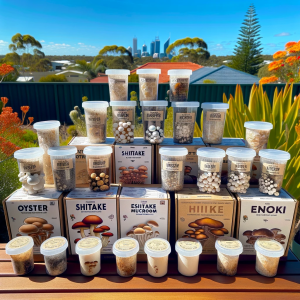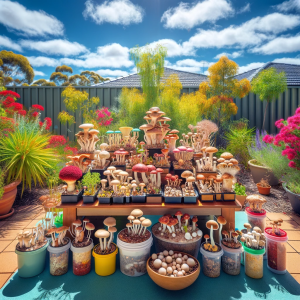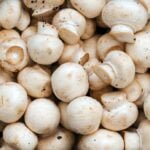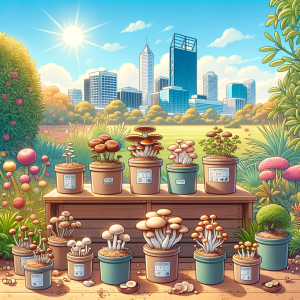mushroom grow kit perth
Whether you are a beginner enthusiast or a seasoned cultivator, mushroom grow kit Perth and Wester Australia offer an accessible and efficient way to grow your own gourmet varieties. With the simple setup and minimal maintenance, you can harvest fresh mushrooms that add flavor and nutrition to your meals. This comprehensive guide will explore the best mushroom grow kits available in Perth, offering you insight and tips to yield a bountiful harvest.
Understanding mushroom grow kit perth
 Mushroom grow kits are self-contained units that provide an all-in-one solution for cultivating mushrooms at home. They are designed to simplify the process of mushroom cultivation, making it accessible and enjoyable for people regardless of their gardening experience or the space available to them. These kits typically include everything needed to start growing mushrooms right out of the box, often leading to a harvest within a few weeks. Understanding the definition and components of these kits, as well as the types of mushrooms you can grow, is the first step toward successful home cultivation.
Mushroom grow kits are self-contained units that provide an all-in-one solution for cultivating mushrooms at home. They are designed to simplify the process of mushroom cultivation, making it accessible and enjoyable for people regardless of their gardening experience or the space available to them. These kits typically include everything needed to start growing mushrooms right out of the box, often leading to a harvest within a few weeks. Understanding the definition and components of these kits, as well as the types of mushrooms you can grow, is the first step toward successful home cultivation.
A mushroom grow kit generally consists of the following components
- Substrate: This is the material that the mushrooms will grow on. It is usually a blend of nutrients and materials such as straw, grains, or sawdust, optimized for mushroom cultivation. The substrate is already inoculated with mushroom spores or mycelium (the vegetative part of the fungus).
- Mycelium Culture or Spores: The kit often comes with a bag or block of substrate that has been pre-inoculated with either mushroom spores or mycelium. This is essentially the ‘seed’ from which your mushrooms will grow.
- Growing Container or Bag: This is where the substrate and mycelium reside. It might be a plastic bag with air filters, a box, or a bucket, designed to create the ideal growing conditions.
- Instructions: Detailed guidelines are usually included to help you set up your kit and care for your mushrooms, ensuring a successful cultivation process.
- Humidity Tent or Bag: Often, to maintain the necessary humidity, a tent or bag is provided to cover the growing container.
By providing the right environment and nutrients, these kits allow mushrooms to grow quickly and healthily, requiring minimal intervention from the grower.
Types of Mushrooms You Can Grow
The beauty of mushroom grow kits is the variety of mushroom species you can grow. Each type of mushroom has its own unique flavor, texture, and growth requirements. Some popular types include:
- Oyster Mushrooms: One of the most popular and easiest to grow. Oyster mushrooms come in
 varieties like pearl, pink, and golden, and are known for their delicate texture and mild, savory flavor.
varieties like pearl, pink, and golden, and are known for their delicate texture and mild, savory flavor. - Shiitake Mushrooms: Famous for their rich, smoky flavor, shiitake mushrooms are a favorite in many Asian cuisines. They are also known for their meaty texture.
- Lion’s Mane: These mushrooms are recognized for their unique, shaggy appearance and are sought after for their potential health benefits as well as their lobster-like taste.
- Button Mushrooms: Also known as white mushrooms, these are the variety most commonly found in grocery stores. They are versatile in cooking and have a mild flavor.
- Portobello Mushrooms: Essentially mature Button mushrooms, these are noted for their large size and deep, meaty flavor. They are excellent for grilling or stuffing.
- Enoki Mushrooms: Known for their slender, noodle-like shape and delicate flavor, Enoki mushrooms are commonly used in soups and salads.
Each type of mushroom has its own specific growing conditions and nutritional needs, which are typically addressed in the design and contents of the kit. It’s important to choose a type of mushroom that not only interests you but is also suitable for your growing environment.
mushroom grow kits are a fantastic entry point into the world of mushroom cultivation, offering an easy, efficient, and satisfying way to grow a variety of mushrooms at home. Whether you’re a gourmet cook looking to add fresh mushrooms to your dishes, a hobbyist seeking a new gardening project, or someone interested in the potential health benefits of mushrooms, there’s a grow kit out there for you. With just a little bit of care and patience, you’ll be able to harvest and enjoy your very own homegrown mushrooms.
Benefits Of Using Grow Kits
Mushroom grow kits have indeed experienced a surge in popularity, largely attributed to the array of advantages they provide to users from all walks of life. These kits are not just about growing food; they are about embracing a hobby that is both productive and rewarding. Below are expanded details on the key benefits these kits offer, explaining why they have become a favored choice for those interested in mushroom cultivation.
Simplicity and Convenience
- No Expertise Required: Mushroom grow kits are designed with the beginner in mind. They come with pre-inoculated substrate and step-by-step instructions, making the cultivation process as simple as following a recipe. This means even those without any prior gardening or mushroom growing experience can successfully grow mushrooms.
- All-in-One Solution: Everything needed to grow mushrooms is included in the kit — substrate, spores or mycelium, and sometimes even a humidity tent or bag. There’s no need to source materials separately, which can be daunting for beginners.
- Space-Efficient: These kits are compact and can fit in small spaces. Whether you have a tiny apartment or a large backyard, you can find a kit that works for your living situation.
- Minimal Maintenance: Once set up, mushroom grow kits require minimal intervention. Typically, all that’s needed is to mist the kit with water to maintain humidity and occasionally check on the growth. It’s a set-it-and-forget-it approach to gardening.
Cost-Effectiveness
- Affordable Start-up Costs: Compared to setting up a full mushroom growing operation, grow kits are relatively inexpensive. They provide a low-cost entry point for individuals who want to try mushroom cultivation without a significant upfront investment.
- Reduced Waste: Because everything is measured and included for the specific purpose of growing mushrooms, there’s less chance of buying too much or the wrong kind of materials.
- Potential Savings: Growing your own mushrooms can save money in the long run, especially if you consume them regularly. Gourmet mushrooms can be pricey when purchased at the store, so cultivating your own can reduce food expenses over time.
Educational Value
- Learning Experience: Grow kits are a fantastic educational tool for people of all ages. They provide a hands-on way to learn about the fascinating life cycle of fungi, from spore to fruiting body.
- Encourages Responsibility and Patience: Tending to a living organism teaches responsibility as you must care for the mushrooms and monitor their environment. It also teaches patience, as mushrooms take time to grow and develop.
- Scientific Exploration: For those inclined towards science, mushroom grow kits offer a glimpse into mycology (the study of fungi). They can spark a deeper interest in biology, ecology, and environmental science.
Mushroom grow kits present an array of advantages, from their ease of use and cost-effectiveness to their educational value. They demystify the process of mushroom cultivation, making it accessible and enjoyable for a wide audience. Whether you’re looking to try something new, reduce your grocery bill, or simply enjoy the satisfaction of growing your own food, mushroom grow kits are a fantastic option to consider.
Setting Up Your Mushroom Grow Kit
Successfully growing mushrooms at home starts with the proper setup of your mushroom grow kit. A good setup ensures that your mushrooms have the ideal conditions they need to thrive. Here’s a step-by-step guide on how to set up your kit, along with some troubleshooting tips for common issues.
Step-By-Step Guide
- Choosing the Right Location:
- Light: Mushrooms don’t require sunlight like plants do, but they do need indirect light to grow properly. Avoid placing your kit in direct sunlight or complete darkness.
- Temperature: Most mushrooms grow best in a cool, stable environment. Check the ideal temperature for your specific mushroom type and try to maintain it.
- Humidity: Mushrooms need a moist environment. The location should support this need, either naturally or with the help of a humidity tent or misting.
- Assembly Instructions:
- Unpack the Kit: Carefully remove all components, including the substrate with inoculated mycelium and any additional materials like humidity tents or bags.
- Prepare the Substrate: Sometimes, you may need to soak the substrate in water or make cuts in the bag, depending on the type of kit. Follow the specific instructions provided.
- Set Up the Growing Area: Place the substrate in the container or bag provided, ensuring it has enough space and is set up according to the instructions.
- Maintenance Instructions:
- Misting: Keep the surface of the substrate moist by misting it with water regularly. Avoid over-watering or allowing it to dry out.
- Ventilation: Ensure there’s enough airflow around your kit to keep the environment fresh and to prevent mold. Some kits come with a ventilated bag to help with this.
- Monitoring: Keep an eye on your mushrooms as they grow. Watch for any signs of growth and adjust the environment as needed.
Troubleshooting Common Issues
- Addressing Mold and Pests:
- Mold: If you see mold, it’s often due to too much moisture or poor ventilation. Adjust your watering practices and ensure the area is well-ventilated. Some molds can be harmful, so wear gloves and a mask when dealing with it.
- Pests: Pests can be deterred by keeping the growing area clean and free from debris. If pests do appear, identify them and look up specific ways to deal with them, as treatments can vary.
- Ensuring Proper Moisture and Light:
- Moisture: Use a spray bottle to mist your mushrooms regularly. The substrate should be moist but not waterlogged. Using a humidity tent or placing a tray of water nearby can help maintain humidity.
- Light: If the mushrooms are too pale, they might need more light (though not direct sunlight). Conversely, if the kit is getting too hot or drying out quickly, it might be getting too much light or heat.
By carefully setting up your mushroom grow kit and addressing any issues promptly, you’ll create an optimal environment for your mushrooms to grow. Remember, different mushroom types might have slightly different requirements, so always refer to the instructions included with your kit and adjust your care accordingly. With patience and attention, you’ll be rewarded with a fascinating growing experience and, ultimately, a delicious harvest!
Maximizing Your Harvest
Once you’ve got your mushroom grow kit set up and your mushrooms are happily growing, you might start thinking about how to maximize your harvest. A larger, healthier yield means more delicious mushrooms to enjoy. Here’s how you can use advanced growing techniques to enhance your harvest and some tips on harvesting and storing your mushrooms effectively.
Advanced Growing Techniques
- Enhancing Growth Conditions:
- Temperature and Humidity Control: Fine-tune the temperature and humidity levels based on the specific needs of your mushroom species. Small adjustments can sometimes lead to significantly better growth.
- Air Exchange: Ensure there’s enough fresh air in the growing area. Stale air can lead to poor mushroom development and increased risk of contamination.
- Light: While mushrooms don’t photosynthesize, light can influence their growth and development. Experiment with the amount of indirect light your mushrooms receive to find what they respond to best.
- Experimenting with Substrates and Hydration Methods:
- Substrate Variations: Once you’re comfortable with basic growing, try different substrates to see if they affect yield or taste. Some mushrooms might prefer coffee grounds, while others might do better with straw or wood chips.
- Hydration Techniques: Experiment with different watering schedules or methods, like soaking versus misting, to see what gives the best results. Just be careful not to overwater, as this can lead to mold.
Harvesting and Storing Your Mushrooms
- Signs Your Mushrooms Are Ready to Harvest:
- Cap Size and Shape: Often, mushrooms are ready to harvest just before their caps fully uncurl or when they reach a certain size. The exact timing can vary between species.
- Gill Exposure: For some species, like Portobellos, exposing the gills can be a sign they’re ready for harvest.
- Overall Look and Feel: With experience, you’ll get a sense of when mushrooms look and feel ready for harvest—firm, plump, and not overly mature.
- Best Practices for Storage and Preservation:
- Immediate Use: Mushrooms are best when fresh, so plan to use them soon after harvesting. They can be stored in the refrigerator for a short period.
- Refrigeration: Store mushrooms in a paper bag in the refrigerator to allow them to breathe and stay fresh for 5-7 days.
- Drying: For long-term storage, mushrooms can be dried. Once dried, they can be rehydrated for use in cooking.
- Freezing: Some mushrooms can be frozen, either raw or cooked, for later use. However, freezing can change their texture, so it’s best used for mushrooms that will be cooked.
By employing advanced growing techniques, you can not only increase your yield but also potentially enhance the flavor and size of your mushrooms. And once it’s time to harvest, knowing how to properly store and preserve your mushrooms can extend the enjoyment of your hard work. Experimenting and learning what works best for your environment and chosen mushroom species is part of the fun and rewarding process of mushroom cultivation!
Beyond The Kit: Expanding Your Mushroom Cultivation
After you’ve had success with a grow kit or two and are feeling more confident about your mushroom cultivation skills, you might start thinking about expanding your operation. Moving beyond the kit allows for greater customization, larger yields, and a deeper connection to the fascinating world of mycology. Here’s how you can transition to larger scale cultivation and become an active member of the mushroom growing community in Perth.
Moving To Larger Scale Cultivation
- Transitioning from Kits to Bulk Substrates:
- Understanding Bulk Substrates: As you scale up, you’ll move beyond the pre-inoculated substrates of kits to preparing and inoculating your own substrates. Common bulk substrates include straw, hardwood chips, and manure, depending on the mushroom species.
- Learning Sterilization and Inoculation Techniques: Successfully preparing bulk substrates often involves pasteurizing or sterilizing them to kill any unwanted bacteria or spores, then inoculating them with mushroom spawn. This process requires some learning and investment in equipment but offers greater control over the growing conditions and potential for a larger yield.
- Designing Your Own Mushroom Growing Space:
- Space Considerations: Evaluate the space you have available. Do you have a spare room, basement, or perhaps a shed that could be converted into a growing space?
- Controlling Environmental Factors: Design your space to control temperature, humidity, and air exchange effectively. This might involve installing insulation, fans, or humidifiers.
- Scaling Up Gradually: Start small to learn what works and what doesn’t in your space before investing in a larger operation.
Joining The Perth Mushroom Growing Community
- Local Workshops and Resources:
- Workshops: Look for mycology or mushroom cultivation workshops in Perth. These are great places to learn advanced techniques and meet others interested in mushroom cultivation.
- Clubs and Societies: Join a local mycology club or society. These organizations often hold meetings, field trips, and other events where you can learn and share knowledge about mushrooms.
- Sharing Experiences and Recipes:
- Community Gardens and Events: Get involved in community gardens or local food events where you can share and learn about different ways to grow and cook mushrooms.
- Online Forums and Social Media: Engage with online communities dedicated to mushroom cultivation. Platforms like Reddit, Facebook, or specialized forums are filled with enthusiasts who share tips, successes, and failures.
Expanding your mushroom cultivation from grow kits to a larger, more personalized operation is a rewarding journey. It allows for greater yields, a deeper understanding of mycology, and the opportunity to connect with a community of like-minded individuals. Whether you’re looking to produce a consistent supply of mushrooms for your kitchen, explore the business side of mushroom cultivation, or simply delve deeper into a rewarding hobby, the possibilities are vast. So, as you move beyond the kit, embrace the learning curve, experiment with new techniques, and become part of the vibrant mushroom growing community in Perth.
Conclusion





 When selecting a kit, it’s also wise to read reviews and possibly connect with local mushroom growing communities in Perth for recommendations based on firsthand experience. Local nurseries or garden centers might also provide valuable advice tailored to Perth’s specific conditions.
When selecting a kit, it’s also wise to read reviews and possibly connect with local mushroom growing communities in Perth for recommendations based on firsthand experience. Local nurseries or garden centers might also provide valuable advice tailored to Perth’s specific conditions.